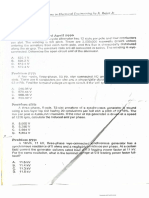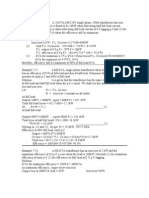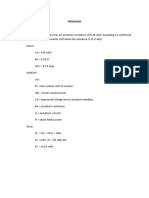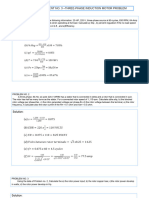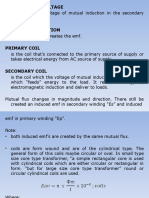0 ratings0% found this document useful (0 votes) 596 views27 pagesLecture Module 1-8
Copyright
© © All Rights Reserved
We take content rights seriously. If you suspect this is your content,
claim it here.
Available Formats
Download as PDF or read online on Scribd
IDEAL TRANSFORMER
ideal transformer is a Joss/ess transformer.
mi
Secondary
o
Primary
Side
Side
E=4.44Nfb > om inwebers; bm =BmA
E=4.44Nfb_x10°% > dm in maxwells
F = voltage induced in the windings
N= number of turns in the windings
f= frequency of the voltage induced
$m = maximum flux in the core
8n = maximum flux density in the core
iE N er oo
eave etvnem jeez Wb il m
Vv turns Hz Mx G cm?
| EXAMPLE: A 60 Hz, 2200-V/220 V transformer is
designed to operate at a maximum flux density of 1 T
and an induced emf of 15 volts per turn. What is the
Cross sectional area (in cm’) of the core?
A=_F/N____15___ 09,0563 m2
4.44fB 4.44(60)(1)
2
A =0,0563 m? x (100-
Zo2 =Ro2 + Xo2
E2 =V2 +12Zo2
Scanned with CamScanner�2 kv/200 V, 50 Hz 4
LE: A single- -phase, 2 1
pen forme! has primary resistance of 3.5 Q and
eactance of 4.5.0. The secondary resistance and
r 0.015 Q and 0.02 Q respectively, Fing
reactance are
equivalent complex impedance referred to primary,
= 2000 10
200
Zo. =2Z1 +2°Z2
= (3.544. 5) +(10)? (0.015 + 0.02)
Zp; =5+ 56.5, ohms
EXAMPLE: A 10-kVA single-phase transformer
designed for 2000/400 V has the following constants, R:
= 5.59, Ro = 0.2 Q; Xi = 12 Q; X2 = 0.45 Q. Solve the
approximate value of the secondary voltage at full load,
i lagging, when the primary supply voltage is 2000
2000
a = 2000 _
400 7°
Roz -Ry += 0.2455 0.420
X02 =X +74= 0.45 + 12 9.939
52
Le- Srated 10,000
25 = ———— = 25 A
V2( rated ), 400
6 = cos? 0.8 = 36,87°
Scanned with CamScanner�g=M= 2000 volts
No) _ 400 \ _
Ey =: (}2) = 2000( $9) = 400 volts
FE, = Vs +152Z.3
400 Za = V2 Z0 + (25 2 - 36.87° (0.42 + j0.93)
400 Za =V> + 22.35 + j12.3
4002 = (V2 + 22.35)? + (12.3)?
V> = 377.46 volts
OPEN CIRCUIT TEST ON A TRANSFORMER
OPEN CIRCUIT TEST ON A I RANSTORMER
i test, the /ow side is supplied with rated
voltage while the high side is /eft open circuited.
Scanned with CamScanner�Tg. = ammeter reading during the test
Px. = wattmeter reading during the test
E- = voltmeter reading during the test
Equivalent Circuit
Note: The wattmeter reading is equal to the core loss
Poc =Peore
2 e
Re = Eo X= Ege
oc Qoc
Qoc = Soc? -Pye? ; Soc =Egcloc
Prore = Core loss
Rco= resistance representing the core loss, in ohms
Xm = magnetizing reactance of the core, in ohms
In = magnetizing current
Scanned with CamScanner�Le: A 500 kVA, 11/2.3 kV, 60 Hz
in n tested and gives the following open ea
Poa KV, 23 A, 4 kW. Determine the nest
pi resistance representing core loss
(b) magnetizing reactance of the core
= 1322.59
—_—
Re =
Poe 4000
{ 2 D
| Eoc 2300
|
s,,=Eocloc = 2300(2.3) = 5290 VA
2
_ 52902 — 40002
Oye = 3461.805 VAR
Ex? 23007 -
_ aE — = 1528 Q
Xy = 2S =
"'Qoc 3461.805
Scanned with CamScanner�SHORT CIRCUIT TEST ON TRANSFORMER.
During the test, the low side is short Citcuited whi}, th
high side is supplied with voltage adjusted so that th 7
high side will draw rated high side current. e
ma)
Psc Ise UY) Shorted
bY |
Ld
Tee = ammeter reading during the test
P.. = wattmeter reading during the test
Fz. = voltmeter reading during the test
Row Xau
Zon
Xon
Esc
Row
Equivalent Circuit
Note: The wattmeter reading is equal to the fullload
copper loss
Psc =Peu (full-load)
=Jz.2-p.2 E.
Xou Zon -Row? ; Zon ==
SC)
Scanned with CamScanner�_ equiv. resistance referred to the high side
fi equiv. reactance referred to the high side
4 2 equiv. impedance referred to the high side
"
AMPLE: A 1-KVA 230/115-V transformer has been
ved for short circuit test and the results are the
following: Esc = 19.1 V; Isc = 8.7 A; Psc = 42.3 W. Find
2 equivalent complex impedance of the transformer
3 d to the high voltage side,
referret
P. 42.3
Rod = = = 0.559.
ee Cee
E 19.1
Zou =-S = =22Q
Ig 8.7
Xo =VZon2 -Ron? =V2.22 - 0.5592 =2.1279
Thus, the equivalent complex impedance referred to the
high side is (0.559 + 2.127) ohms
COPPER LOSSES IN A TRANSFORMER
Sper loss (Pcu) — \osses due to heating in the
transformer windings due to resistance.
Scanned with CamScanner�Poy =1y7Ry +1p7Rp
=1,?Roi =1n°Rqp
EXAMPLE: A 30 kVA, 2000/200 V, single-phase
transformer has primary resistance of 3.5 9 and
reactance of 4.5 Q. The secondary resistance ang
reactance are 0.015 © and 0.02 © respectively, Fing ty
load copper loss.
_ 30,000 _ 45 A 30, 000
= S000 200
Pay =1?Ry + 1y°Ro
P,, = (15)2(3.5) + (150)2(0.015) = 1125 W
=150A
ALTERNATE SOLUTION:
2000
a=-——=
200
Rog = Ro + "2 =0.015+ 35-0050
a 102
10
Poy = 1p’Rop = (150)* (0.05) = 1125 W
PPER LOSSES OF THE TRANSFORMER
AT X-SIZE OF LOAD
Let: x = decimal equivalent for the size of load
Carried by the transformer in reference to
its full load value
© yy?
Pou(x-load) = (x) Pcucfull-load)
Scanned with CamScanner�PLE: The full load copper Io
SS of ;
en w, Solve the copper loss at hal | “oe is
& (y\2
Pruthalt-load) = (x) Peu(full-toad)
= (1/2)? (6400)
= 1600 W
CORE LOSS OF A TRANSFORMER
core losses are losses due to Aysteresis and eddy
quent losses in the magnetic circuit (core) of the
transformer.
(-1.6
Py =k (Bm! ® Ph =ky| =
{ f0-6
Pe =Kf*°Bm? Pe SkgE?
P, = hysteresis loss, in watts
Pe = eddy current loss, in watts
k= proportionality constant
fe frequency of the input supply voltage
5, = maximum flux density in the core
EXAMPLE: The hysteresis loss in a 6,600 V, 60 Hz
transformer is 480 W. What will be the loss when the
transformer is connected to a 6,900 V, 40 Hz source?
Scanned with CamScanner�mh=k 706
a 0.6
fa = (e] 8)
1 (Er) (fe
1.6 0.6
Ap = 480 (o> (=) = 657.33 watts
EFFICIENCY OF A TRANSFORMER
Efficiency is a ratio between power delivered or output
to the power intake or input of the transformer. This is
sometimes called commercial efficiency.
Ae Pout _ Pout
Pin Pout + Pou + Peo
Pout = (x)(Pratea )>P=Sepf
Pout = output power delivered
Py = input power delivered
x = size of load
Pey = Copper loss of the transformer
Peo = core loss of the transformer
Scanned with CamScanner�|
EXAMPLE: A 50-KVA, 4,600/230-volt, 60-Hz
ansformer has a full load copper loss of 615 watts and
core loss of 285 watts. Calculate the percent efficiency
when the transformer is delivering,
(a) rated load at a pf of 0.8
(b) quarter-load at a pf of 0.9
Pout(FL) = Srated ° pf
Pout(rt) = 50,000(0.8) = 40,000 w
Pout(FL)
Pout(FL) + Poucety + Poo
40,000
ee 0,
40,000+6i5.285 8%
TFL =
TRL
Pout(aya) = 4(Srated ° pf)
= +(50, 000)(0.9) = 11,250 w
Poucx) =X*PouceL)
Pou(1y2) =(4)? (615) = 38.44 W
——__Poutaryay
Pout(a/4) * Peui/4) + Peo
11,250
1/4 = 77950 + 38.44 + 285
= 97.205%
Scanned with CamScanner�MAXIMUM EFFICIENCY OF A TRANSFORMER
To operate at maximum efficiency, the copper loss of
the transformer must equal to the core /oss.
Pout(max)
Nm =
Pouty max) + 2Poore
Size of load (x) at maximum efficiency,
X= Peo a
Pou(FL)
Load current (Iz) at maximum efficiency,
b= Poore
\ Roe
Load (Sjoas) at maximum efficiency,
Pp
Sload = Srated P a
cu
Scanned with CamScanner�; E: A 25-kVA single-ph
AMPLE: A 2 g!e-phase transforme
nated core loss and copper losses of 300 W fd ow
cove the maximum efficiency at 0.8
pf lagging.
Sjoad = Stated
Sad = 2 s = 17.677 kVA
Note: Poag = Stoad x pf
ee ee
Pout +2Pcg 17, 677(0.8) + 2(300)
1m = 95.93%
Scanned with CamScanner�ALL-DAY EFFICIENCY
All-day efficiency is the ratio of the energy Output of
delivered within a 24-hour period to the ener
i i 5 input ;
the same period of time. It is sometimes Called ph in
efficiency. { Slergy.
Wout
N all-day) == -
out + Wey + Woo
Wow = output energy
We, = energy lost in the copper windings
We = energy Jost in the core
Wout = 2 (Pout ¢ t)
Weu =X (Poy ot)
Woo =Peo et
t = time of transformer usage, in hours
Note: If the transformer is connected to the primary
lines the whole day (loaded or not), the multiplying
factor for Wey is 24 hours.
Pout =(X)(Srated )(Pf)
Pu = (x)? Pcu(FL)
x = size Of load, in decimal value
pf = operating power factor
Srated = apparent power rating of the transformer
Pet) = full load copper loss
Scanned with CamScanner�MPLE: A 3-kVA transformer has a core loss of 30
wand 4 full load copper loss of 75 W. Solve the all day
efficiency for the following loads: 1 ¥% times the rated
kya, pf = 0.85, 2 hrs; rated kVA, pf = 0.9, 5 hrs; 34
rated KVA, Pf = 0.95, 6 hrs; Ya rated kVA, pf = 1.0, 7
hrs; no-load, 4 hrs. ‘
Wout = XO&)MSratea )( pF )(t)
= (1.5)(3)(0.85)(2) + (1)(3)(0.9)(5)
+(0.75)(3)(0.95)(6) + (0.5)(3)(1)(7)
Wout = 44.475. kWh
Wey = D(X)? Peucery (0)
= (1.5)? (0.075)(2) + (1)? (0.075)(5)
+(0.75)? (0.075 )(6) + (0.5)* (0.075 )(7)
Woy =1.1 kWh ;
Wop = Peg ot
Weo = (0.030)(24) = 0.72 kWh
7 Wout
(all-day) =
Wout + Weu + Weo
n = ne = 96.068%
(all-day) “44.475 + 1.1 40.72
Scanned with CamScanner�PER UNIT VALUE IN TRANSFORMER PARAMETERS
gan a A Tee)
The per unit value of any quantity is defined as the ray,
of the quantity to its base or reference value.
For single-phase system:
_ Ease — Epase”
Thase Sbase
Zactual _ Sbase Zactual
Zhase Eyasa”
Sbase i
lbase = pues 2base
base
pu =
For three-phase system:
: 2
lense = Spase_. 7 _ Ebase(LL)
. V3Ebase is Spase
Zpy = Zactual . Sbase Zactual
Zpase — Ease(LL)”
Ease = line to line voltage rating, (V)
Stase = rated apparent power, (VA)
Zactuat = Ohinic impedance, (ohm)
Scanned with CamScanner�' AMPLE! A 50 kVA, 2400/240 v transformer has a
ar unit reactance of 5%, Solve the equivalent ohmic
"tance of the transformer referred to the primary.
. SpaseXohmic
me Ebase
2
_ XpuEbase(ty” _ 0.05(2400)?
tt Shase 50,000
| Xp, = 5.76 ohms
Scanned with CamScanner�PER UNIT VALUE BASED ON A NEW VOLTAGE Bs
AND NEW POWER BASE E
2
P-U.(new) -[enm | cold-base
P.U. (old) Sold-base Enew-base
EXAMPLE: The per unit impedance of a transformer is
2%, based on 50 MVA and 13.8 kV. Solve the new per
unit impedance if the base is change to 100 MVA ang
6.9 kV? _
Sold-base Enew-base
2
100 \/13.8
= co 25
50 JL 6g )
2
as Snew-base Eold-base
Zpu(new) oe Zpu(old) Scere | eee
Zpu(new) =16%
Scanned with CamScanner�VOLTAGE REGULATION
centage voltage ‘regulation is the percentage rise in
Frage in the secondary side after the load is switch-
off
£, = terminal voltage at no load
\) = terminal voltage at rated load
Erin. Even
OBVR = —e-toad) 7 =(fulhload)_
E (Full-load)
E2 -V2
2
%VR =
Vp “4
Alternate formula using per unit data:
%VR =) (cos 0+ %IR)* +(sin O + VIX)? -1
tsign = for a lagging pf
- sign = for a leading pf
Note: If the pf is lagging, the voltage regulation is a
Positive value while if the pf is leading the voltage
regulation is a negative value. a
Scanned with CamScanner�EXAMPLE: A 7.2 kVA, 1.2 kv/120 V, single-phase
transformer has the following winding parameters; p, .
0.8.0, Xi = 1.2. Q, Ro = 0.01.9, and X = 0.01 a,
Determine the voltage regulation of the transformer
when it is delivering rated load at 0.8 pf lagging,
Solve the equivalent impedance referred to the
secondary side:
a= 120-10
120
0.8+j1.2
AL _ (0,01 + j0.01) +S
we 10
Zp = 0.018 + j0.022
Zo2 = 22 +
Stated 7200 =
In(rated) = = OA
o(rated) 120
Roz Xo2
Equivalent Circuit referred to Secondary Side
E, =V2 +1pZq2
= 120 + (60 4 - 36.87° )(0.018 + j0.022)
Ez =121.656 20.192°
E,-V2 _ 121.656 - 120
V2 120
%VR =
= 1.38%
Scanned with CamScanner�seRNATE SOLUTION:
i
Srated202_ _ (7200)(0.018 +. j0.022)
oC
to vy? (120)2
ea 0.009 + j0.011
050 = 0:8; sin = 0.6
wR = \(COSO + %IR)* + (sind + IX)? —1
= (0.8 + 0.009)? + (0.6 + 0.011)? 4
%HVR = 1.38%
POLARITY TEST ON A TRANSFORMER
The Polarity of a transformer refers to the re/ative
rections of the induced voltage in the primary and
Secondary windings with respect to the manner in which
the terminal leads are brought out. Proper transformer
Polarity is needed when transformers are connected in
Parallel or when transformers are banked.
Scanned with CamScanner�External connections
a
Vis less than V1 V is greater than V,
(Subtractive Polarity) (Additive Polarity)
EXAMPLE: A 2300-V/230-V distribution transformer is
tested for polarity in accordance to the standard
method. If 110 V is impressed across the Hi and H2
terminals, what will be the voltmeter reading if
(a) the polarity is additive ©
(b) the polarity is subtractive
E, Np (=) |
a =-4 56 =110)/ =~ |=1
EN 2 2300 | 1 volts
If additive polarity, reading = 110+ 11 =121V
If subtractive polarity, reading = 110-11 =99V
PARALLEL OPERATION OF TRANSFORMERS
Like generators, transformers are also operated in
‘paralle/to supply a bigger common load and to prevent
overloading the transformers.
Scanned with CamScanner�ieee ol ti
yea ‘the same voltage rating for both
Primary and
"secondary
the transformer must be Properly connected as to
"polarity
the ratio of the equivalent resist;
equivalent reactance must be th
‘ance to the
e same
Equivalent circuit
referred to secondary side
= equivalent impedance of T; referred to sec.
equivalent impedance of T> referred to sec.
urrent delivered by T;
current delivered by T>
le
. = load voltage or terminal voltage
& = secondary induced emf
1,Z2 121
e+; 1p =o
Z, +Z2 2, +22
: :
Z SZ
#572 ge Se Zi
S
z “Zy +2, Z, +Z>
Note: s,s, and St are conjugate apparent power
Values £0 for leading pf and -0 for lagging pf
Scanned with CamScanner�EXAMPLE: Two transformers A and B are connecteg
parallel. The respective impedances referred to the in
secondary are (0.5 + j4) Q and (0.8 + j6) Q. The total
load on the transformer is 120 kVA at 0.8 pf lagging
power factor. Calculate the kW load on transformer A,
« Stotar Zp _ (1202 ~ 36.87°)(0.8 + j6)
SA = Za4Zy (0.5+)4) + (0.8 +}6)
Sq = 57.482 kW - j43.407 KVAR
EXAMPLE: Two transformers A and B are operated in
parallel to share a load of 125 kVA at 0.8 pf lagging.
Transformers are rated as follows: A: 100 kVA, 0.9%
resistance, 10% reactance; B: 50 kVA, 1% resistance,
5% reactance. Find the kVA share of transformer B.
Note: Since the transformers have different power
ratings, convert first the per unit impedances to a
common power base. Assume 100 MVA as the new
power base. Convert the pu impedance of B based on
100 MVA:
100
Zou(new) = (0.01 + jo.05)( "2° = 0.02 + j0.1
‘ St Za _ 1252 - 36.87°)(0,009 + j0.1)
Za+Zp (0.009 + j0.1) + (0.02 + j0.1)
Sg = 62.1032 - 33.76°, kVA
[Sp| = 62 kVA
Scanned with CamScanner






